Navigation
Install the app
How to install the app on iOS
Follow along with the video below to see how to install our site as a web app on your home screen.
Note: This feature may not be available in some browsers.
More options
You are using an out of date browser. It may not display this or other websites correctly.
You should upgrade or use an alternative browser.
You should upgrade or use an alternative browser.
Reef2Reef Pest algae challenge thread hydrogen peroxide
- Thread starter brandon429
- Start date
- Tagged users None
Jena thanks for stopping in, feel free to post any algae battles you may do
The best part of the modified method here is no tank commitment on first go, it's possible to lightly test-use peroxide and pose no danger.
each peroxide thread online is always how much can I dump into my tank...we like to consider just starting with a test area. Peroxide might not test out to be the right tool for the job, then we wouldn't use it.
But if it does test, we want the before and after pics ~
am pleased to see modifications and application approaches here that show initiative for options beyond the standard tank dose, many invaders require some extra effort.
Concentrator devices, amalgamations with other chemicals, underwater spot injections, mainly external treatments...hopefully our thread will be different than others. I bet it becomes really results-oriented...predictions should be able to be made and fulfilled to either validate or invalidate the method. It's fun to continue various tank trials as the pages build, we can prove its not a haphazard molecule at all. Peroxide doesn't have to take the place of traditional algae control methods...it can be a boost should they fail. Clearing mass out of a tank quickly helps you balance long term prevention better than having to starve out a mass slowly. nutrient controls are evaluated based on grow-back stoppage, not the ability to remove existing set-in algae. We differ by keeping prevention and removal two different actions...the sum total is being algae free, always, every day.
Mushroomboy try to grab pics before and after of your target areas if you can~ before and after pics are our currency
The best part of the modified method here is no tank commitment on first go, it's possible to lightly test-use peroxide and pose no danger.
each peroxide thread online is always how much can I dump into my tank...we like to consider just starting with a test area. Peroxide might not test out to be the right tool for the job, then we wouldn't use it.
But if it does test, we want the before and after pics ~
am pleased to see modifications and application approaches here that show initiative for options beyond the standard tank dose, many invaders require some extra effort.
Concentrator devices, amalgamations with other chemicals, underwater spot injections, mainly external treatments...hopefully our thread will be different than others. I bet it becomes really results-oriented...predictions should be able to be made and fulfilled to either validate or invalidate the method. It's fun to continue various tank trials as the pages build, we can prove its not a haphazard molecule at all. Peroxide doesn't have to take the place of traditional algae control methods...it can be a boost should they fail. Clearing mass out of a tank quickly helps you balance long term prevention better than having to starve out a mass slowly. nutrient controls are evaluated based on grow-back stoppage, not the ability to remove existing set-in algae. We differ by keeping prevention and removal two different actions...the sum total is being algae free, always, every day.
Mushroomboy try to grab pics before and after of your target areas if you can~ before and after pics are our currency
Last edited:
Here's the eventual aftermath of my spot and fog testing. My carbonates, CO2 and carbon levels went bonkers from intense spot dosing and fogging in a few areas. I don't suggest trying to attack a tank as aggressively as I did. It killed bristle worms, pods and most of my turbos. The carrib cerite and nassarius snails didn't seem to mind any of it, even with an alk close to (or over) 20dkh. Also the fish never seemed stressed and shrimp never molted. One peppermint molted last night from the leftovers I found tonight. Not unusual. Also, the red tree sponge does not seem affected at all either and I dosed it directly, under water, due to algae growing on it. I would have expected some cellular decay due to O2 ending up inside the pores. We'll see!
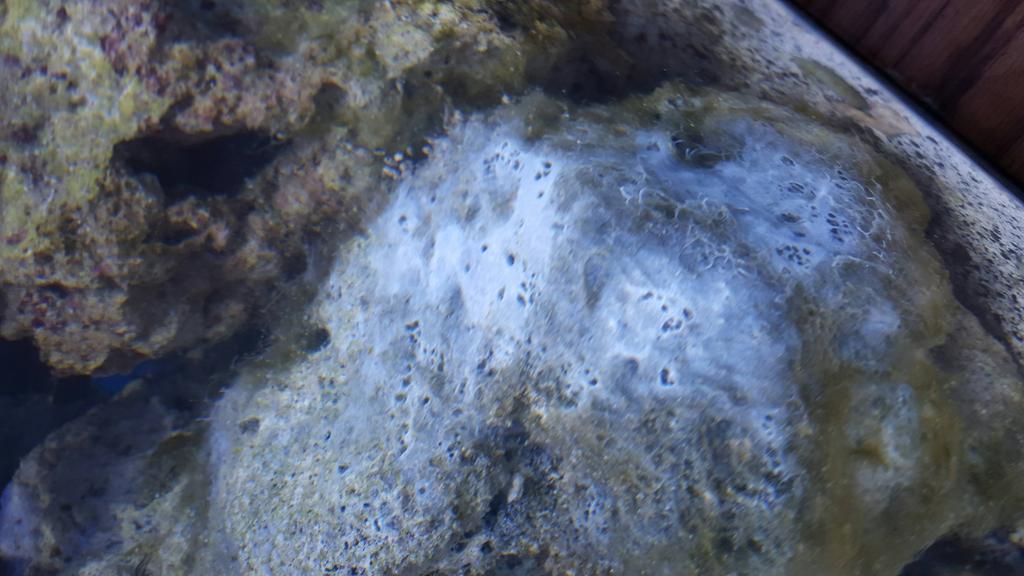
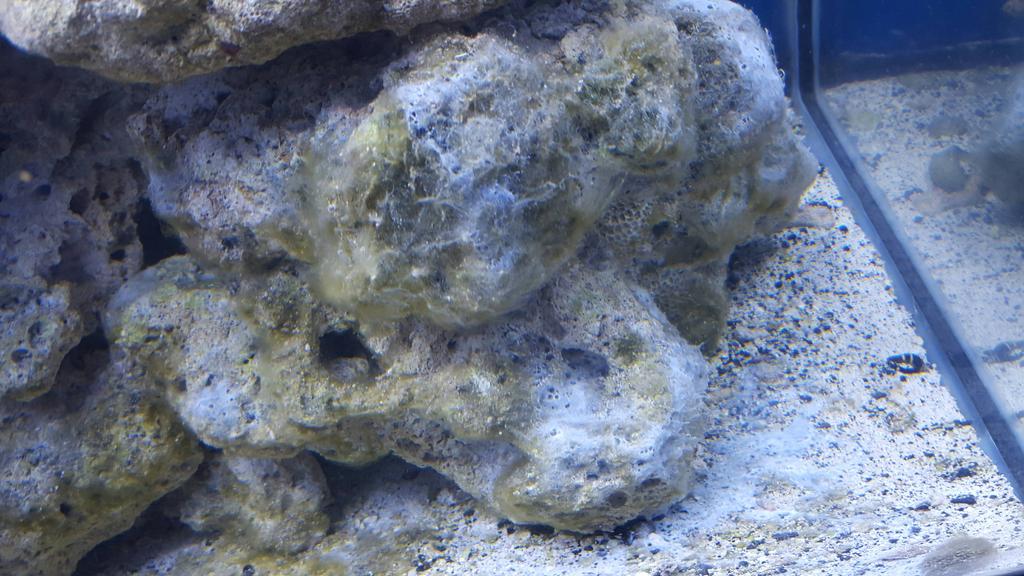
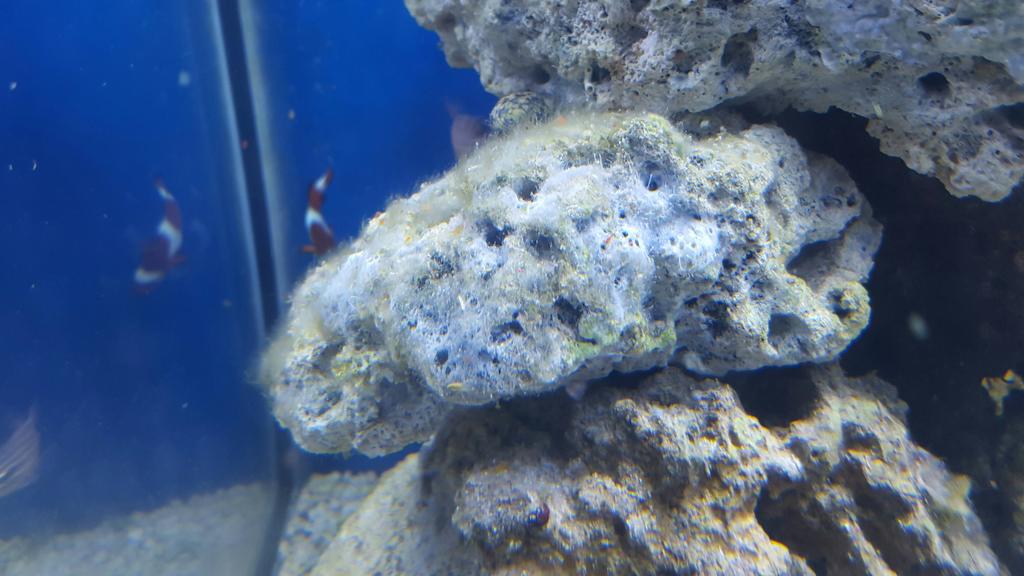
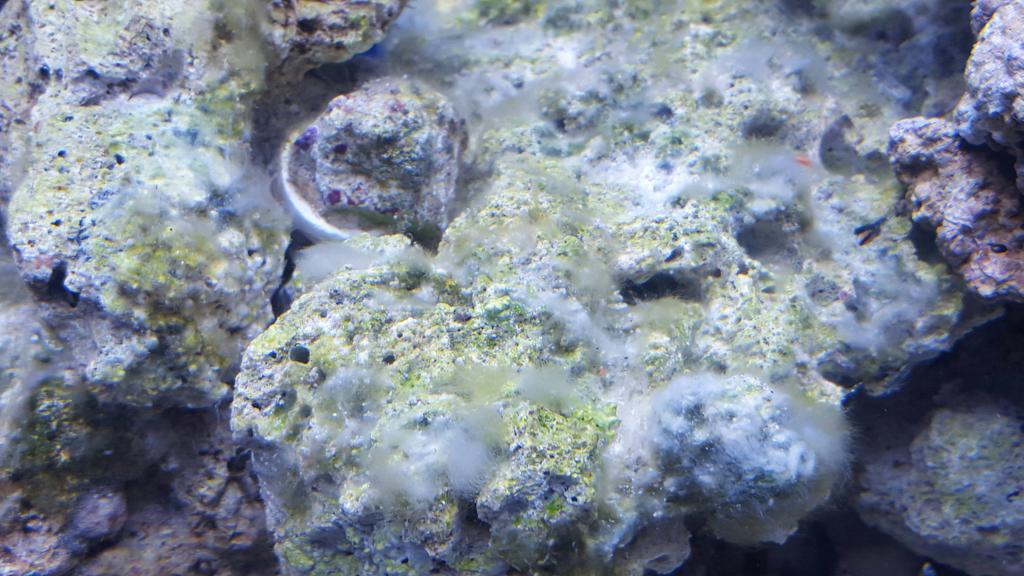
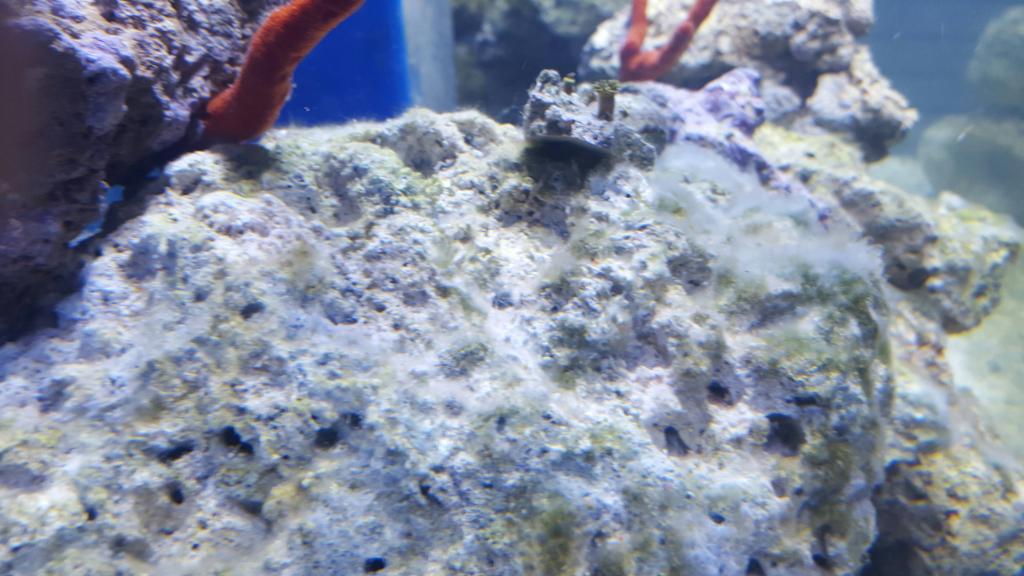
The daily sewage dump... 1.5 weeks now and it's still filling up daily with decomposing organics.
I took a brush to the white fuzz and strings all over the rocks, where I could reach without toppling the wall.
The dead fibers just flicked off under the bristles like any other detritus, leaving clean rock in most of the areas.
The cloudy pics are during rock scrubbing.
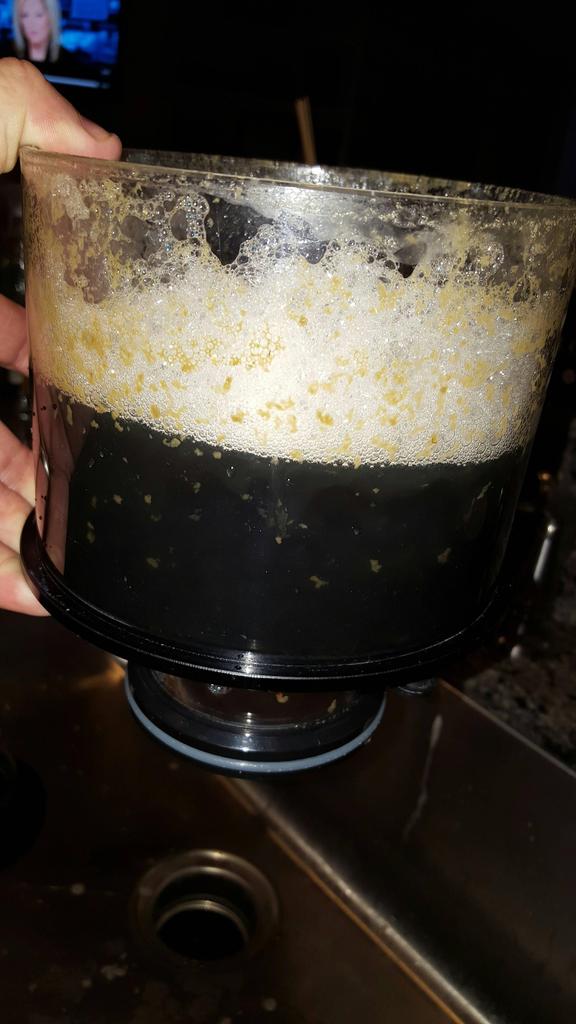
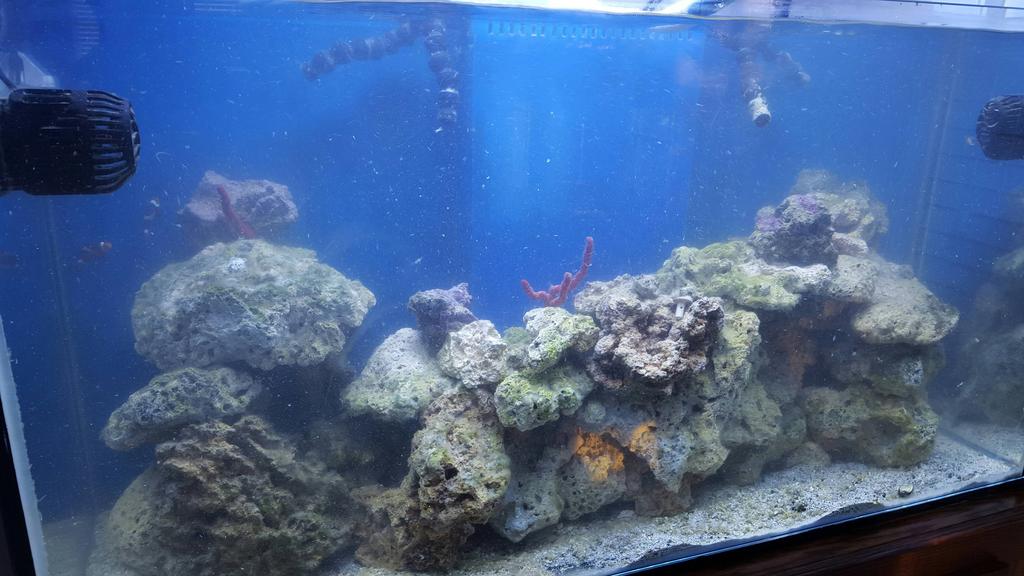
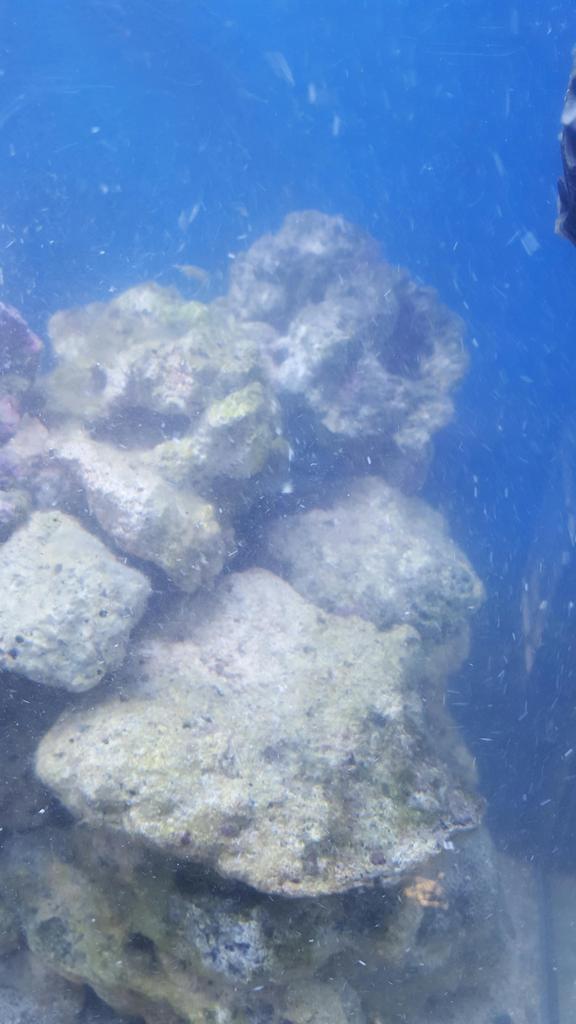
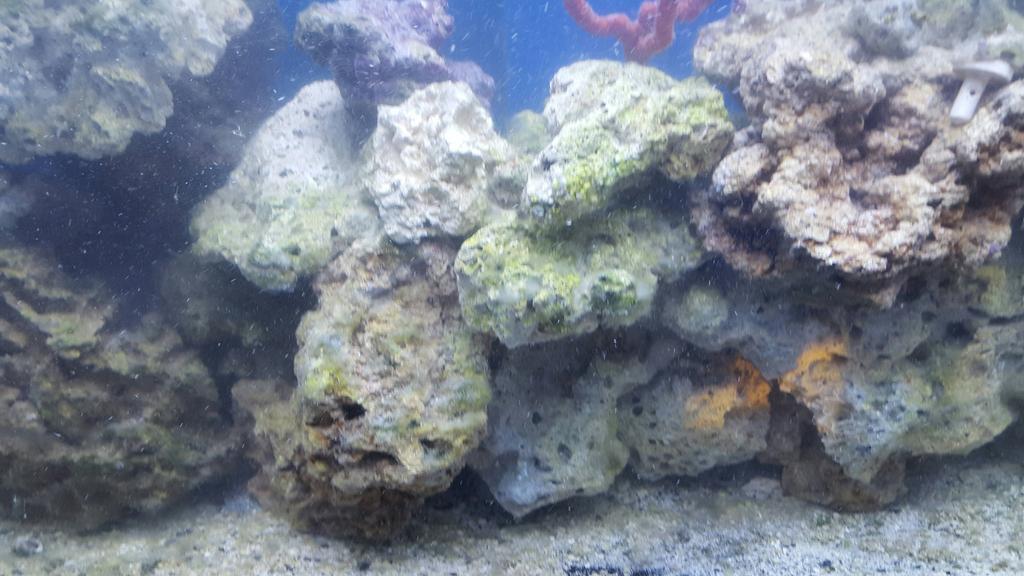
After:
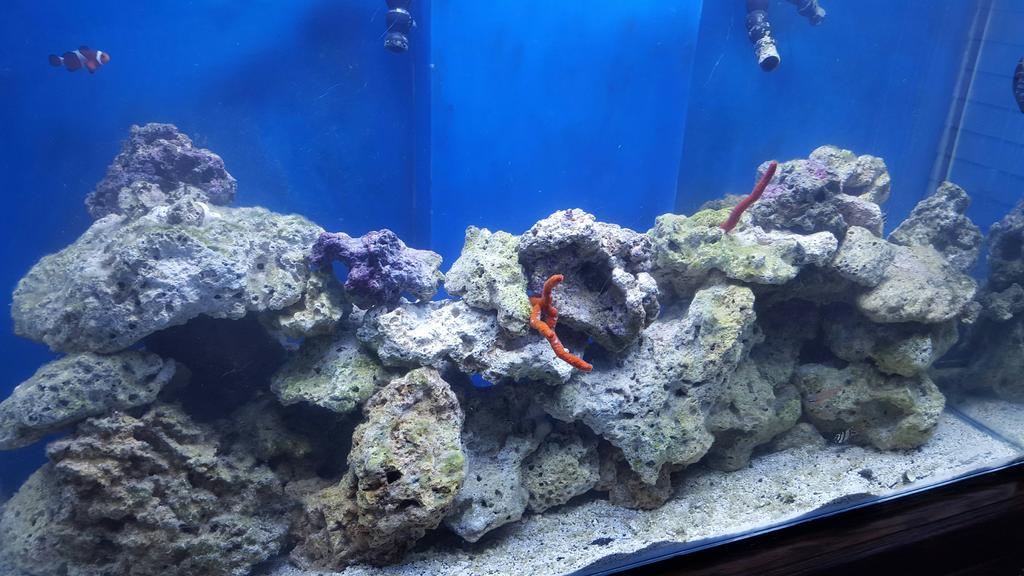
I am still getting some "fairway" growth in a couple places, which the starry blenny likes to snack on. The snails and shrimp are cleaning up everything else as it rots.





The daily sewage dump... 1.5 weeks now and it's still filling up daily with decomposing organics.
I took a brush to the white fuzz and strings all over the rocks, where I could reach without toppling the wall.
The dead fibers just flicked off under the bristles like any other detritus, leaving clean rock in most of the areas.
The cloudy pics are during rock scrubbing.




After:

I am still getting some "fairway" growth in a couple places, which the starry blenny likes to snack on. The snails and shrimp are cleaning up everything else as it rots.
That is valuable and detailed work I couldn't be happier to see your summations
learned a lot from the pms
well done shocking after pics.
learned a lot from the pms
well done shocking after pics.
Today marks one week since I treated my rocks and I finally have a chance to post a proper followup. The immediate results of the treatment were truly remarkable, with a near complete removal of what I believe is a mix of bryopsis and GHA. To recap my process, I removed all of my rocks and sprayed them (generously) with 3% H2O2 covering most of the rocks and left each one out for about 5 minutes prior to rinsing in tank water from a water change, and then returning to the aquarium. All affected creatures seem to be recovering, with the exception of an acropora that is still showing signs of struggling. After the initial thrill of seeing this wipe out my algae, I am noticing that it was merely down, but not out. I have areas of regrowth and am wondering when I should re-treat (I'm imagining sooner than later). Any opinions or input is appreciated. Now onto the photo evidence.
My tank at its worst just a couple of weeks ago...

2 days after treatment...

And finally, what appears to be the start of another round...

My tank at its worst just a couple of weeks ago...

2 days after treatment...

And finally, what appears to be the start of another round...

excellent follow up~
the retreat is normal as this was the first go, against an invader months set in with holdfast systems and regenerative bits cast into the tank in various places, its a -guiding- process to clean it out. the benefit featured here is less biomass, not more, the arrest process beginning. that which was almost able to creep up and intertwine corals is now set back, the direct benefit. purely ridding it is a nice luxury we strive for, this is the cost of delayed action and Im only saying that to new readers who have one single tuft of algae, and are considering leaving it in the tank for any reason.
Regarding your growback I see these options:
-that was 3% work, consider the boosted percentages we reviewed, 35% is knockout strong, and only one option you may want to consider others instead, but since its what I use with massive results, 35% cannot be discounted. it simply burns better than 3% as external treatments, with less growback. it is markedly dangerous obviously heh, 3% isn't.
-grazers that were missing from the initial equation (nature has bryopsis grazers galore) can be introduced now, they'll love the damaged stalks. true nature comparisons to your tank are not about starving your targets with nutrients, they are about grazers that prevent a takeoever. Needing grazers to control future issues is valid long term control, have to experiment to see what works. The fact the algae was there at all implies they were missing from original design.
-its no offense to consider actual GFO nutrient controls, or any other method here during your growback session assessments. We've stated that preventatives work much better when the original mass was removed, so that they don't have to be amplified as the remover and overstrip your water column harshly (total coral bleaching risk)
nutrient adjustments and grazer adjustments and stronger pct is a valid consideration for your growback controls. these pics and posts are gold pop back in soon to let us know, growback control is our strongest challenge in true challenge tanks, not the initial kill.
the retreat is normal as this was the first go, against an invader months set in with holdfast systems and regenerative bits cast into the tank in various places, its a -guiding- process to clean it out. the benefit featured here is less biomass, not more, the arrest process beginning. that which was almost able to creep up and intertwine corals is now set back, the direct benefit. purely ridding it is a nice luxury we strive for, this is the cost of delayed action and Im only saying that to new readers who have one single tuft of algae, and are considering leaving it in the tank for any reason.
Regarding your growback I see these options:
-that was 3% work, consider the boosted percentages we reviewed, 35% is knockout strong, and only one option you may want to consider others instead, but since its what I use with massive results, 35% cannot be discounted. it simply burns better than 3% as external treatments, with less growback. it is markedly dangerous obviously heh, 3% isn't.
-grazers that were missing from the initial equation (nature has bryopsis grazers galore) can be introduced now, they'll love the damaged stalks. true nature comparisons to your tank are not about starving your targets with nutrients, they are about grazers that prevent a takeoever. Needing grazers to control future issues is valid long term control, have to experiment to see what works. The fact the algae was there at all implies they were missing from original design.
-its no offense to consider actual GFO nutrient controls, or any other method here during your growback session assessments. We've stated that preventatives work much better when the original mass was removed, so that they don't have to be amplified as the remover and overstrip your water column harshly (total coral bleaching risk)
nutrient adjustments and grazer adjustments and stronger pct is a valid consideration for your growback controls. these pics and posts are gold pop back in soon to let us know, growback control is our strongest challenge in true challenge tanks, not the initial kill.
Last edited:
Put a large turbo on that rock and let him have at it. It'll be gone in a day or two. If it starts taking off quickly, pull it out and try another dosing of straight 3%. If you're ready for an in-tank treatment trial, go with a mix of 50/50 glycerin USP (food grade) and 3% peroxide. Mix until it blends completely and looks like water again. Use a large nozzle syringe or an oral medicine doser and slowly flood the area with it. You'll see refraction in the water from it as it sinks and spreads. Do not dose more than 10ml at a time unless you have a strong carbon removal system. The glycerin is a concentrated carbon source but we are using it for its higher density than sea water to sink the peroxide and fill the pores of the rock before the peroxide starts oxidizing. Give it about 2 minutes and you'll see it start reacting and it should continue reacting for about 10 minutes if you have a lot of organics in the rock pores. It WILL bleach your coralline but it will come back pretty quickly.
I'm working on a couple of mix dosing tests to try to get the glycerine content as low as possible without losing the weight and "time-release" effectiveness of the two combined. My tank is settling finally so I will start additional tests this week more than likely. I have some 1:1 and 2:1 mix cartridges and a dispensing gun on order and should have them this weekend. The plan is to pre-fill the cartridges and keep them available to for easy dosing and mixing during treatment cycles. I'm just not sure how well the mix nozzles are going to blend the two. I'll know soon, though.
2:1 ratio of peroxide to glycerine is as effective as 1:1 for spot dosing. .5ml per gallon of mix, max every 48 hours and the carbon source should be consumed completely. Do not continue dosing until your skimmer calms down, unless you are prepared for a full nitrogen restart. A filter sock is recommended to keep your skimmer cleaner. It will likely clog up after each treatment.
- Joined
- May 2, 2014
- Messages
- 64
- Reaction score
- 31
Peroxide successfully kills back my particularly hideous-looking brown hair algae, but it comes right back. If I squirt it all over the rock outside the tank, it appears to kill the bacteria film and I go through a diatom bloom... then the diatoms fade out and the original BHA comes back.
It's extremely time consuming and detrimental to my SPS doing it outside the tank. I broke countless pieces and lost a couple of colonies in the commotion. In-tank spot treating is appealing to me, but the glycerine thing described above sounds a little scary with the alk swings... not for me.
I was wondering what a peroxide/kalk paste would do, but most of my problem areas are right around the base of corals and I imagine the kalk would burn them pretty bad.
Any other ideas for an in-tank carrier for the peroxide?
It's extremely time consuming and detrimental to my SPS doing it outside the tank. I broke countless pieces and lost a couple of colonies in the commotion. In-tank spot treating is appealing to me, but the glycerine thing described above sounds a little scary with the alk swings... not for me.
I was wondering what a peroxide/kalk paste would do, but most of my problem areas are right around the base of corals and I imagine the kalk would burn them pretty bad.
Any other ideas for an in-tank carrier for the peroxide?
The alk swings are mostly due to the baking soda and glycerine slurry I tried. I had no alk swings with 50ml of 2:1 this time and my skimmer calmed down overnight. The glycerine is just a carbon source, but the density and affinity for lighter liquids makes it a good sinking and release agent. Try 5ml on one spot and see if it bleaches out overnight. You'll need to take your time dispensing it so it pools and sinks into the surface layer of the rock. Turn off all agitation sources.
Once it bleaches out, lightly scrub the dead filaments off and treat again. I'd wait 48 hours between treatments to give the bacteria time to digest the carbon and clear out. If you don't wait long enough you'll end up with a jelly-clogged sock and slime everywhere. It'll clear up, of course, but it really makes the sump nasty and you have to clean everything.
- Joined
- May 2, 2014
- Messages
- 64
- Reaction score
- 31
I don't think the concentrator idea will work here because of how close to the coral it is... unless I cover the coral with it, too which I'm not much keen on. I'll try spot treating with a syringe first and see what happens. Not sure I'm brave enough to try the glycerine yet, but that might be the next step if this doesn't have any effect.
Also, if I open a new bottle of 3% peroxide today and wait a few days to treat again, do I need to open a new bottle then, too? Or is the seal broken for a few days okay?
Thanks
Also, if I open a new bottle of 3% peroxide today and wait a few days to treat again, do I need to open a new bottle then, too? Or is the seal broken for a few days okay?
Thanks
Few days is fine for sure. I'm down with a pre test small area since it will be for sure sps side contact, treading more carefully watching the coral vs the target. In prioritizing coral safety with these pre-tests we know some tanks may not be fitted for peroxide in-tank and other methods can be tried (each with its own pro and con, many a bleached coral sets can be found in catch-up nutrient stripping threads)
If an external spot treat didn't sustain it, we think an underwater method won't even still. The external treatments are the ideal kill ones, the in tanks are diluted/weaker on target but a simple pre test can confirm
If an external spot treat didn't sustain it, we think an underwater method won't even still. The external treatments are the ideal kill ones, the in tanks are diluted/weaker on target but a simple pre test can confirm
- Joined
- May 2, 2014
- Messages
- 64
- Reaction score
- 31
f an external spot treat didn't sustain it, we think an underwater method won't even still. The external treatments are the ideal kill ones, the in tanks are diluted/weaker on target
External treatment DEFINITELY had a massive impact on it. I think what I have now is just remnants of the detritus circulating in the water column. The way the algae seems to be growing out crevices and alongside of coral makes me think that. I'll try to get some pics.
- Joined
- May 2, 2014
- Messages
- 64
- Reaction score
- 31
Well I was thinking 'what nuclear algae doest this man have to resist the all powerful surface burn'
Ha
I would think it's nuclear, but nuclear stuff is lime green, isn't it? hahaha
Sorry for the crappy cell pics, it doesn't show the algae very well. I tried to shine a flashlight on thicker spots to highlight it.



You do not "fog" a small area or where collateral damage can be done, when you are targeting. You push the syringe tip down into the algae a mm or so above the rock and dispense a small amount, then move over and dispense. Keep going around the area until you covered it. The glycerine will not affect the coral. The peroxide will though. I use a 5ml oral medicine doser to treat my frags and growth near coralline. Even my 50/50 fresh water and 3% did not eliminate algae on my coralline rocks. It has come back, but is slow to grow now. I am spot treating with 2:1 peroxide to glycerine 50ml max for my 90g. Most of it has bleached out again and is dying. 3rd week of treatment and I am 95% algae free.
- Joined
- May 2, 2014
- Messages
- 64
- Reaction score
- 31
You do not "fog" a small area or where collateral damage can be done, when you are targeting. You push the syringe tip down into the algae a mm or so above the rock and dispense a small amount, then move over and dispense. Keep going around the area until you covered it. The glycerine will not affect the coral. The peroxide will though. I use a 5ml oral medicine doser to treat my frags and growth near coralline. Even my 50/50 fresh water and 3% did not eliminate algae on my coralline rocks. It has come back, but is slow to grow now. I am spot treating with 2:1 peroxide to glycerine 50ml max for my 90g. Most of it has bleached out again and is dying. 3rd week of treatment and I am 95% algae free.
You've done this every 48 hours for 3 weeks and it's still not completely gone...? Ughhhh
Similar threads
- Replies
- 10
- Views
- 197
- Replies
- 1
- Views
- 211
- Replies
- 4
- Views
- 406
- Replies
- 1
- Views
- 293
- Replies
- 11
- Views
- 270


















